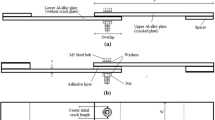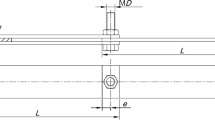Abstracts
High-strength steel hybrid joints that combine adhesive and bolts have been studied both experimentally and numerically. The fatigue strength of the double lap joint has been experimentally measured under completely reversed cyclic loading. Finite element analysis was used to estimate the stress state at the contact interface of the lap joint. The fatigue strength of bonded and clamped interfaces which have previously been characterized using napkin ring specimens has been combined with the finite element results. The region of the double lap joint which showed fretting damage corresponded well with the region estimated to have significant damage based on the assessment. The resulting fatigue strength assessment was conservative with respect to the experimental results.
















Similar content being viewed by others
Abbreviations
- d :
-
Loading level interval between subsequent fatigue tests in the small sample staircase series
- D :
-
Damage variable of the cohesive interface model
- E :
-
Young’s modulus
- F :
-
Longitudinal load applied to the double lap joint specimen
- \( {\mathit{\mathsf{F}}}_{\mathsf{a}} \) :
-
Load amplitude applied during the double lap joint experiment
- \( {\mathit{\mathsf{F}}}_{\mathsf{a},0} \) :
-
First load amplitude level of the staircase sequence
- \( {\mathit{\mathsf{F}}}_{\mathsf{a},\mathsf{f}} \) :
-
Load amplitude corresponding to the estimated fatigue strength
- \( {\mathit{\mathsf{G}}}_{\mathit{\mathsf{c}}} \) :
-
Fracture energy
- k :
-
Parameter based on the staircase sequence
- \( {\mathit{\mathsf{K}}}_{\mathsf{nn}},{\mathit{\mathsf{K}}}_{\mathsf{ss}},{\mathit{\mathsf{K}}}_{\mathsf{tt}} \) :
-
Cohesive stiffness component in the normal and in the two shear directions, respectively
- \( {\mathit{\mathsf{N}}}_{\mathsf{f}} \) :
-
Number of cycles to failure
- P :
-
Longitudinal load applied to the double lap joint finite element model as surface pressure
- \( {\mathit{\mathsf{P}}}_{\max } \) :
-
Maximum load during the double lap joint simulation
- \( {\mathit{\mathsf{P}}}_{\min } \) :
-
Minimum load during the double lap joint simulation, maximum compressive load
- q :
-
Static normal stress on the interface of the modified napkin ring specimen
- \( {\mathit{\mathsf{t}}}_{\mathsf{n}},{\mathit{\mathsf{t}}}_{\mathsf{s}},{\mathit{\mathsf{t}}}_{\mathsf{t}} \) :
-
Cohesive traction in the normal and in the two shear directions, respectively
- \( {\overline{\mathit{\mathsf{t}}}}_{\mathsf{n}},{\overline{\mathit{\mathsf{t}}}}_{\mathsf{s}},{\overline{\mathit{\mathsf{t}}}}_{\mathsf{t}} \) :
-
Elastic traction without damage in the normal and in the two shear directions, respectively
- \( {\mathit{\mathsf{t}}}_{\mathsf{n}}^0,{\mathit{\mathsf{t}}}_{\mathsf{s}}^0,{\mathit{\mathsf{t}}}_{\mathsf{t}}^0 \) :
-
Critical cohesive traction in the normal and in the two shear directions, respectively
- α :
-
Coefficient of the exponential damage evolution model
- Δ :
-
Interface relative displacement during a modified napkin ring experiment
- \( {\varDelta}_{\mathsf{gap}} \) :
-
Displacement measured by the clip-on gage during the double lap joint test
- \( {\varDelta}_{\mathsf{tot}} \) :
-
Total displacement measured by the built-in sensor during the double lap joint test
- \( {\delta}_{\mathsf{n}},{\delta}_{\mathsf{s}},{\delta}_{\mathsf{t}} \) :
-
Cohesive relative displacement in the normal and in the two shear directions, respectively
- \( {\delta}_{\mathit{\mathsf{m}}} \) :
-
Effective separation
- \( {\delta}_{\mathit{\mathsf{m}}}^0 \) :
-
Effective separation at onset of damage
- \( {\delta}_{\mathit{\mathsf{m}}}^{\mathsf{f}} \) :
-
Effective separation at full cohesive fracture
- \( {\delta}_{\mathit{\mathsf{m}}}^{\max } \) :
-
Maximum effective separation attained during the loading history
- μ :
-
Coefficient of friction
- ν :
-
Poisson’s ratio
- σ 2 :
-
Calculated contact pressure on the interface
- τ 1 :
-
Calculated interface shear stress along the global 1-direction
- \( {\tau}_{\mathit{\mathsf{II}}} \) :
-
Measured shear stress during a modified napkin ring experiment
- \( {\tau}_{\mathsf{f}} \) :
-
Shear stress amplitude corresponding to the estimated fatigue strength of the bonded and clamped interfaces
- CZM:
-
Cohesive zone modelling
- DLJ:
-
Double lap joint
- FEM:
-
Finite element method
- HSS:
-
High-strength steel
References
Hurme S, Marquis G (2013) The effect of clamping stress on the fatigue strength of bonded high-strength steel interfaces. Weld World 57:285–292
Oinonen A, Marquis G (2011) A parametric shear damage evolution model for combined clamped and adhesively bonded interfaces. Eng Fract Mech 78:163–174
Hurme S, Oinonen A, Marquis G (2011) Fatigue of bonded steel interfaces under cyclic shear loading and static normal stress. Eng Fract Mech 78:1644–1656
Oinonen A, Marquis G (2011) Shear decohesion of clamped abraded steel interfaces reinforced with epoxy adhesive. Int J Adhes Adhes 31:550–558
Dixon WJ, Mood AM (1948) A method for obtaining and analyzing sensitivity data. J Am Stat Assoc 43:109–126
Dixon WJ (1965) The up-and-down method for small samples. J Am Stat Assoc 60:967–978
Little RE (1974) The up-and-down method for small samples with extreme value response distributions. J Am Stat Assoc 69:803–806
Nowell D, Dini D, Hills DA (2006) Recent developments in the understanding of fretting fatigue. Eng Fract Mech 73:207–222
Ciavarella M, Demelio G (2001) A review of analytical aspects of fretting fatigue, with extension to damage parameters, and application to dovetail joints. Int J Solids Struct 38:1791–1811
Nesládek M, Španiel M, Jurenka J, Růžička J, Kuželka J (2012) Fretting fatigue—experimental and numerical approaches. Int J Fatigue 44:61–73
Benhamena A, Talha A, Benseddiq N, Amrouche A, Mesmacque G, Benguediab M (2010) Effect of clamping force on fretting fatigue behaviour of bolted assemblies: case of couple steel–aluminium. Mater Sci Eng A 527:6413–6421
Chakherlou TN, Razavi MJ, Abazadeh B (2013) Finite element investigations of bolt clamping force and friction coefficient effect on the fatigue behaviour of aluminium alloy 2024-T3 in double shear lap joint. Eng Fail Anal 29:62–74
Wagle S, Kato H (2009) Ultrasonic detection of fretting fatigue damage at bolt joints of aluminium alloy plates. Int J Fatigue 31:1378–1385
Volkersen O (1938) The rivet load distribution in tensile loaded riveted joints with constant lap cross sections (Die Nietkraftverteilung in zugbeanspruchten Nietverbindungen mit konstanten Laschenquerschnitten). Luftfahrtforschung 15:41–47
Kwakernaak A, Hofstede J, Poulis J, Benedictus R (2010) Improvements in bonding metals (steel, aluminium). In: Dillard DA (ed) Advances in structural adhesive bonding. Woodhead Publishing Limited, Cambridge, pp 185–236
De Bruyne NA (1944) The strength of glued joints. Aircr Eng 16:115–118
Tsai MY, Oplinger DW, Morton J (1998) Improved theoretical solutions for adhesive lap joints. Int J Solids Struct 35:1163–1185
Osnes H, McGeorge D (2009) Experimental and analytical strength analysis of double lap joints for marine applications. Compos B 40:29–40
Gonçalves JPM, De Moura MFSF, de Castro PMST (2002) A three-dimensional finite element model for stress analysis of adhesive joints. Int J Adhes Adhes 22:357–365
Griffith AA (1921) The phenomena of rupture and flow in solids. Philos Trans R Soc A221:163–198
Castagnetti D, Dragoni E, Spaggiari A (2011) Failure analysis of complex bonded structures: experimental tests and efficient finite element modeling by tied mesh method. Int J Adhes Adhes 31:338–346
De Moura MFSF, Gonçalves JPM, Chousal JAG, Campilho RDSG (2008) Cohesive and continuum mixed-mode damage models applied to the simulation of the mechanical behavior of bonded joints. Int J Adhes Adhes 28:419–426
Roe KL, Siegmund T (2003) An irreversible cohesive zone model for interface fatigue crack growth simulation. Eng Fract Mech 70:209–232
Moroni F, Pirondi A (2011) A procedure for the simulation of fatigue crack growth in adhesively bonded joints based on the cohesive zone model and different mixed-mode propagation criteria. Eng Fract Mech 78:1808–1816
Khoramishad H, Crocombe AD, Katnam KB, Ashcroft IA (2010) Predicting fatigue damage in adhesively bonded joints using a cohesive zone model. Int J Fatigue 32:1146–1158
Abaqus user manual, version 6.12, 2012
Hobbacher A (2009) IIW recommendations for fatigue design of welded joints and components. WRC bulletin 520. The Welding Research Council, New York
Acknowledgments
This work was supported by the Finnish Graduate School in Engineering Mechanics. Partial support was also provided by Ruukki Metals Oy and the Finnish Metals and Engineering Competence Cluster (FIMECC). CSC—IT Center for Science Ltd. is acknowledged for the allocation of computational resources.
Author information
Authors and Affiliations
Corresponding author
Additional information
Doc. IIW-2472, recommended for publication by Commission XVI “Polymer Joining and Adhesive Technology.”
Rights and permissions
About this article
Cite this article
Hurme, S., Marquis, G. Fatigue experiments and finite element analysis of bolted/bonded double lap joints. Weld World 58, 771–785 (2014). https://doi.org/10.1007/s40194-014-0157-4
Received:
Accepted:
Published:
Issue Date:
DOI: https://doi.org/10.1007/s40194-014-0157-4




